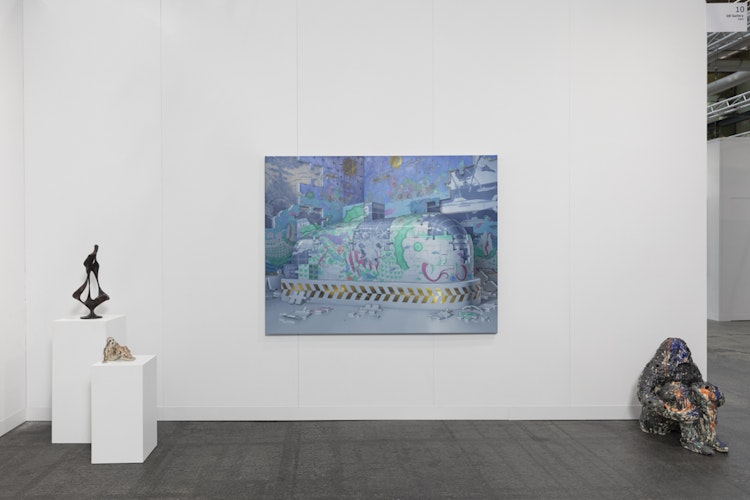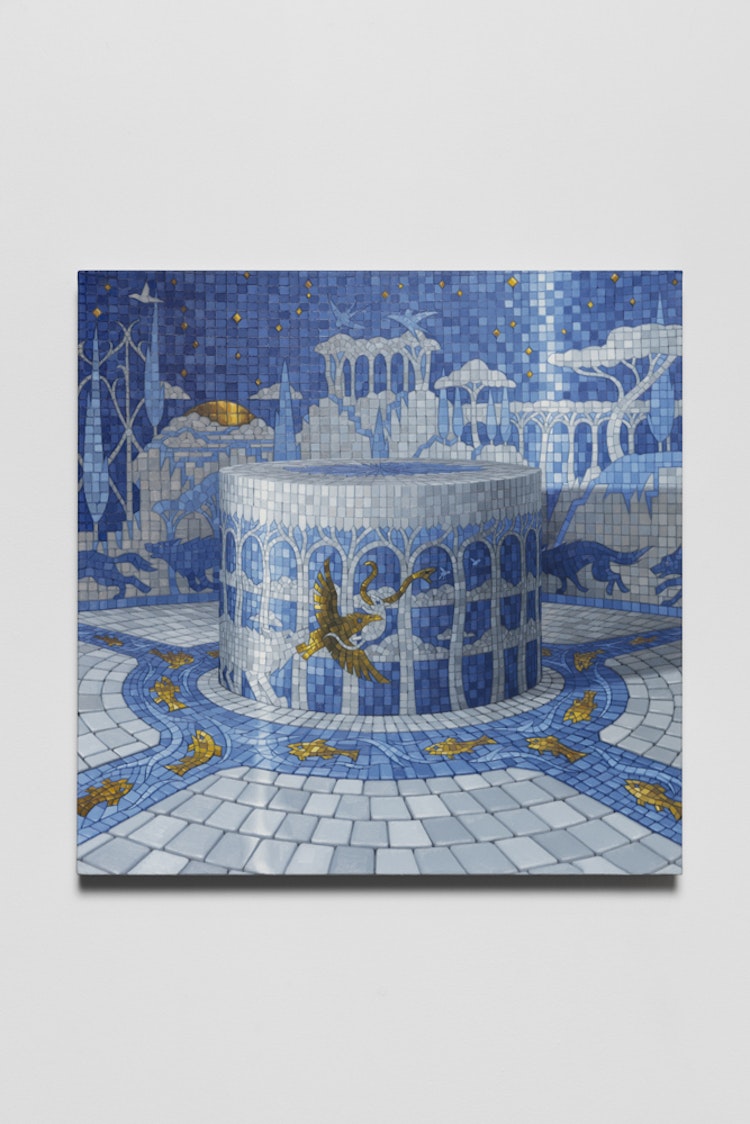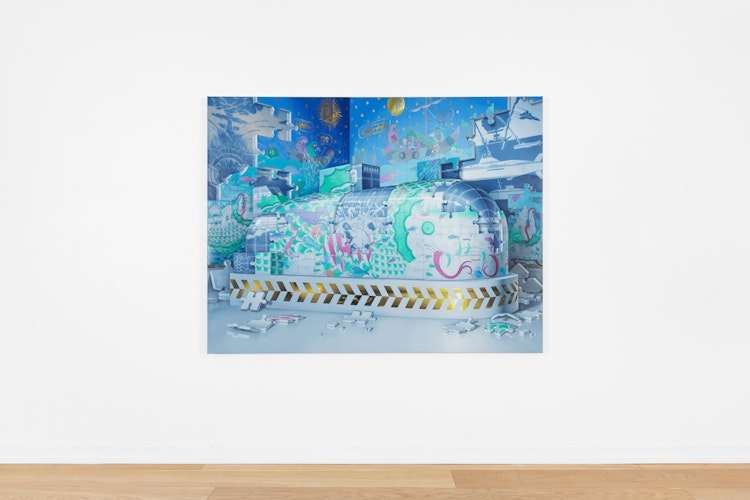10 questions with Bjørn Båsen


On the occasion of the new edition of Enter Art Fair in Copenhagen, we asked Bjørn Båsen, one of the artists on view, 10 questions regarding his work, career, inspirations, and the story behind his new artworks exhibited at Enter.

Bjørn Båsen (b. 1981, Eggedal, Norway) has a BA from The Arts Institute at Bournemouth and an MA from the Oslo National Academy of the Arts.
Båsen’s works invite the spectator into a whole new world. His skillful perspectives make one feel as though you could take a leap and fall into his illusion of a blissful wonderland. However, in his world of porcelain puzzles, cracks are always present and propped with references to deep and often dark matters. Båsen’s oeuvre is filled with references to mythology, past and present decadence – the fairytales of former glory meet the realism of today.
His work is included in the collection of the Astrup Fearnley Museum, KODE Art Museum, Nordnorsk Kunstmuseum, the National Museum of Decorative Arts and Design, The Grieg Art Collection, Equinor, DNB as well as numerous private collections nationally and abroad.
Here are his words.
/1
QB: Do you remember your very first approach to art? What did you find fascinating about it?
BB: I got my first drawing pad when I was one and a half years old and after that I drew non-stop. There are two works that stuck with me whilst growing up. The first was Gustav Wentzel's painting "Breakfast", which I saw on my first visit to the National Gallery in Oslo. I guess I was nine or ten years old. The materiality of the painting made a big impression. I particularly remember the light and the shine of the porcelain cup in the boy's hand. The second work is "One and Three Chairs" by Joseph Kosuth. I was introduced to this conceptual work in art history class in high school, and it gave me a much deeper understanding of what visual art could be. Where the reference and philosophy of the idea is the main focus and not the purely visual. It's still one of my favourite artworks.
/2
QB: What has influenced you the most in your career? How has this changed over time?
BB: This is a very difficult question to answer, because in my case, I am influenced by everything I do. Whether it's study trips, films, exhibitions, books, conversations, social media. I think the closest thing I have to a concrete answer is fear and my gut feeling. When my gut feeling tells me I'm on the right track, I follow it. The same goes for ideas and concepts that scare me. When I refuse to realise a work because I'm afraid of how it will be received, I know it's worth creating. That’s how it’s always been like for me.
/3
QB: What do you think the role of an artist is in today’s society?
BB: I think different artists have different roles, but I do think that some of us are trying to make people stop and reflect. To linger. Today, if you can make people forget time and place, then you've really achieved something unusual. Art and artists are often small pieces in a larger art machinery. If a work can break out of this collage and take back some autonomy, then you're on the right track.

/4
QB: How would you describe your own artistic expression?
BB: Conceptual, surreal and narrative are probably the terms I would. It's neither bird nor fish. My works often play on the contrast between surface versus content, where I hope that the viewer will participate in a guessing game to get to the bottom of the meaning in the artwork.
/5
QB: From idea to finished artwork, how are your artworks made? Do you follow a particular process or “ritual”?
BB: The idea often comes many years before the work is started. When the basic idea has matured and a complete image forms in my head that feels finished, I create some sketches. When I work with painting, I spend a long time sketching on the canvas. And this is where the motif itself is decided. All details and ideas are carefully chosen, and ideas from the sketch stage are changed or discarded. After a week or two of sketching, the actual painting begins. And this takes a long time. Usually between two to three months of intense work. Since I paint things that don't exist, I don't have any models to refer to. Everything has to be taken from my thoughts. That's why I usually start with an test layer to determine light and colours. Once this is done, I refine the entire painting again. At this stage, I can correct things that weren't right in the first layer and give the painting the texture and depth I'm looking for.
When it comes to sculpture, the process is quite similar up to the sketching stage, but after that the process is very different. I'm a drawer who paints and a painter who sculpts. In other words, I wasn't born a sculptor, but I bring many of the ways of thinking as a painter into the medium of sculpture. My sculpture sketches are usually very different from the finished sculpture, as the actual construction of the object must relate to what is possible to create in three-dimensional form. My sculptures are made using a mixed technique of wood and mdf. Once this is fully shaped, it is covered in a layer of thin fabric (often gauze) soaked in hide glue. Finally, 10-20 layers of gesso (a mixture of hide glue and chalk) are applied to form a ceramic-like film on the outside of the sculpture. This is sanded down so that the surface is smooth, and then the sculpture is decorated with paint, gold leaf, or other mediums.
/6
QB: In a number of your paintings we can glimpse text that is not visible at first glance, but which becomes clear as the viewer gets closer to the painting. What is the relationship between art and literature in your artistry? Do you think that a work of art can be approached in the same way as a literary work?
BB: My works are very personal. They reflect what I'm interested in at the moment. I'm a nerd and therefore I like to get to the bottom of themes. Right now I'm very fascinated by how history repeats itself. The fact that my generation has grown up in a time and in a part of the world that has been unusually peaceful and stable for over half a century. But the Western world has become more and more unstable in recent years, in other words: things have returned to normal.
I realise that for my generation, this new situation is frightening to deal with, simply because we're not used to it. If you're a history nerd on the other hand, like me, this is something that has happened before and will happen again. "The present as past" is a theme that appears in several of my recent works.

/7
QB: In your artworks, you often refer to themes that can be linked to historical events or other narratives, often with dark shadow sides. The works appear universal and timeless, but at the same time very modern in form, color and composition. How do you choose which stories to highlight? Are there certain themes that you think are particularly relevant today?
BB: I usually find the best themes in books. But until a couple of years ago, I hadn't thought about the similarities between literature and my work in painting or sculpture.
In 2022, I finished a ten-metre-long painting for the exhibition "Mythos" at Nitja Centre for Contemporary Art, which tells the story of the impact of the Napoleonic Wars on the Norwegian constitution. It depicts various historical events from the early 1800s, disguised as a fantasy computer game. When it was hanging on the gallery wall, I realised it was my first novel. Until then, I had only worked in short story format. My single narrative paintings function as short, standalone stories, but every once in a while it's fun to attempt an epos.
/8
QB: A common trait in your artworks is that they open up for several layers of interpretation: one layer is immediately linked to composition and subject matter, and the second one is a more perception-based layer linked to iconography and symbolism. This causes the viewer to search for clues in the work that lead them to an understanding of what they are observing, almost like a treasure hunt, where one notices several elements in each new encounter with the work. How do you relate to other people's interpretations of your works? Can other people's interpretations affect how you view your own artworks?
BB: When I was younger, I had a strong need for everyone to interpret my work in the same way. But I quickly realised that this was futile. Now I look forward to hearing other people's interpretations, often because I learn from it. My view is very subjective, but I want my work to be as accessible as possible. I wouldn't say that other people's interpretations change the core of my work, but I try to let it be an aid so that I don't mislead the viewer unnecessarily.
If an idea is completely new, it can be helpful to see which elements people are drawn to in the artwork. This way I discover qualities that I either wasn’t aware of or which makes it possible to reinforce other elements that people may have missed.
/9
QB: Can you tell us a bit about the artworks by you on view at Enter Art Fair 2023?
BB: I'm participating at Enter with three oil paintings. One large and two smaller ones. The largest is a painting from the "Chronicle" series. It's inspired by a Mark Twain quote: "History never repeats itself, but it does often rhyme". As mentioned before, I am fascinated by the present as the past and "Chronicle (Submarine)" emphasises this.
The work depicts two stories: a war with nuclear-powered submarines and a post-apocalyptic world where submarines have become mythical monsters lying at the bottom of the sea.
The painting was made in two stages - I lived for three months in Rome in-between. There I became aware of developments in Europe after the fall of the Roman Empire. People in Britain and France were no longer part of a large empire and went back to a more simple agricultural society. When the younger generation asked for an explanation as to who had built the great ruins in the field, the answer was: giants. This is what the painting is about. How the distinction between historical events and myths is blurred.
The two small paintings at the fair were made during my stay at Circolo Scandinavo in Rome and are a part of a new series that uses mosaics as a starting point. The first, "Pixel (Aeternus)", is my attempt to create a painting of Rome. In the 18th and 19th centuries, Rome was a popular theme in art history. "All" artists would visit the city and create their own depiction of the city. Today, this is an extinct genre, but I felt it was a natural theme for me to work with mosaics in painting. The second painting, "Pixel (Inferno) I", is based on the first verse of Dante Alighieri's masterpiece "The Divine Comedy". The text depicts how he is lost in the forest and does not know where to go next. The forest is a metaphor for Dante's own life, and I have chosen to depict this as an overgrown urban landscape where text fragments appear as advertising posters and graffiti.
/10
QB: Last question: If you were to have dinner with five other artists, living or not, who would it be?
BB: Artists are often introverts, so I think I would choose a group that already knows each other. It would probably be a loud dinner, but one where everyone got along well. The answer is the five founders of the Preraphaelites: James Collinson, William Holman Hunt, John Everett Millais, Dante Gabriel Rossetti and Thomas Woolner.
The critic John Ruskin was also part of this "fraternity", but he is said to have been an unsavoury figure, so I'll stick to the first five.
What are you looking for?